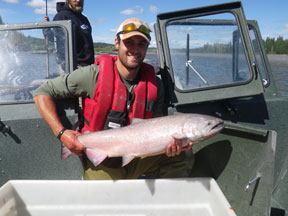Graeme Zaparzynski, College Intern II
Sport Fish Division - Glennallen

Before my senior year at Slippery Rock University, I was fortunate enough to spend three months as an intern with the Department of Fish and Game Sport Fish Division based out of Glennallen, Alaska. I can confidently say that my three months in Alaska will be something I will never regret. I spent time working on three different projects both in the research and management branches of Sport Fish and worked with technicians and biologists who shared my common interests in the outdoors and preserving the country's wild fisheries.
As an intern my main job was collecting otolith samples as well as length and sex data from sockeye and Chinook salmon caught in the subsistence and personal use fisheries of the Copper River, while also ensuring fisherman properly followed fishing regulations. The otolith samples as well as sex and length data collected from the sampled fish are used to help manage the fishery for best future use. My sampling area consisted of a large stretch of river which had to be broken into specific sections in order to meet the desired quota of 100 fish every week. Communication and adaptability were vital for me as I coordinated my schedule to meet with local fish wheel owners and users while they cleaned their catch. At the end of each sampling day the otoliths and field data I collected were transferred into trays and onto data sheets in order to be sent for lab analysis.
I also spent one week working on the Gulkana River counting tower where the goal was to determine the escapement of sockeye and Chinook Salmon to that point in the river. This project was based out of a remote camp on the river where each team member spent roughly 8 hours a day counting the salmon that made their way up river on their spawning run.
Lastly, I was able to spend several days working on a Chinook salmon radio telemetry project with the offices research biologist on the Gulkana River. Using dipnets and rod and reel, the goal of the project was to catch and tag Chinook salmon in order to study movement of the fish on their spawning run and gain knowledge as to how water temperature and water level affect the spawning fish. The fish that we caught were either tagged internally or externally before being released with care to resume their journey upriver. Tracking stations along the river as well as flight surveys over the river were used to map the location of the tagged fish in the river throughout the spawning season.
During each of these projects I was able to apply concepts that I have learned throughout my coursework and gain knowledge into the challenges and tasks of fisheries biology. As I prepare myself for a career in which I hope to preserve and improve our country's waterways I can, without a doubt, say that my experiences as an intern in Alaska will stick with me for the rest of my life. Most importantly I was able to see what it takes to be successful at a professional level and I cannot be more thankful to the Department of Fish and Game staff in Glennallen for the opportunity and experience that they have given me!
